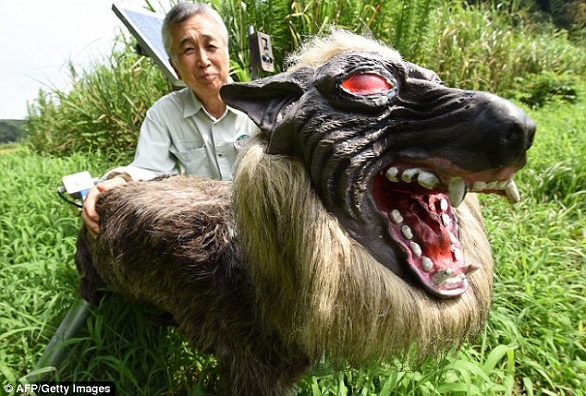
-
Published: 01 October 2023

Japan is witnessing an increase in the number of Bears at a time when the country is witnessing a decline in the population and aging.
EDITED BY| HUXIANA
Asia section - CJ journalist
Tokyo– October,1,2023
Authorities say the number of bear attacks in Japan is rising at an alarming rate.
Government data estimates that there are about 12 thousand brown bears in the Hokkaido region, while some experts estimate the number of bears
Black Asian by about 10 thousand.
With bright red eyes, chilling howls, exposed fangs, animals rush to hide at the sight of which, Japan
A robotic wolf is designed to keep wild animals away from farms, but recently the Japanese authorities are using this mechanical Wolf to prevent
Bears can enter urban areas and attack people.
The robot wolf was used for the first time in Takikawa city in the fall of 2020, said Motohiro Miyasaka, president of the company
The manufacturer of the Wolf Wolf camoy. Since then, local governments have ordered increasing numbers of robotic monster launches
On it his name is "Wolf-Beast".
Experts say that the main reason is that the Japanese, especially young people, are leaving villages and rural agricultural areas. He emigrated
Many of them to major cities, which led to the emptiness of villages or towns that are already experiencing a significant decline in population due to
The problem of aging that Japan is facing.
Shinsuke Koike, a professor at the Tokyo University of Agriculture and Technology, whose research focuses on Bears and biodiversity, said
And forest ecosystems: "more and more agricultural lands in the foothills that served as buffer zones between Bears and humans are disappearing".
As a result, little bears over the decades moved to neglected forests, lived near cities, got used to bright lights and loud noise, and I became less afraid of humans.
Bears have become roaming residential areas as their habitat has expanded from mountains to flat lands closer to communities humanity.
Fierce brown bears can be seen in the far north of Hokkaido. Over the past six decades, more than 150 attacks have occurred for bears in Hokkaido.
At least four people were killed and 10 injured in 2021, one of the bloodiest years in Japan on launch.
Asian black bears are found in the rest of Japan. They can be identified by a light-colored spot that resembles a crescent moon on
Their breasts, which are less aggressive, but no less dangerous.
Bears are usually seen and the incidents associated with them occur around April, when they wake up from their winter hibernation in search of
Food, then again in September and October when you eat to store fat for the winter months. But the attacks Fatal rarely falls.
"But statistically speaking, if the number of attacks and injuries increases, the chances of death are likely to increase," Koike said People too".
The situation was aggravated by the low productivity of acorns, the largest food source for bears, partly due to climate change.
The nut harvest is usually associated with a boom-bust cycle, it means that a bountiful harvest in a year can be followed by a season
Production will be scarce the following year, and a bad year may become even worse when severe storms, which are becoming more frequent now, lead
Due to climate change, to the destruction of crops.
And global warming can also affect walnut trees in other ways. A 2015 study showed that
Warmer weather may result in lower nut yields due to the disruption of pollination.
Oak trees, bearing Walnut fruits, usually bloom at the same time, which is what allows the most successful cross-pollination.
But the warmer spring seasons, as a result of global warming, prolong the flowering period and cause the flowering of oak trees
In a less synchronous way. This can reduce the yield of Oak in the fall by about 20%, said Tim sparks،
Professor at Coventry University and one of the authors of the study.
Further poor harvests could lead to more bears coming out into people's yards in search of food.
"What we need to think about now is how to bring the Bears back to the mountains,"Koike said.
The main problem, according to Tsutomo mano, a research biologist at the Hokkaido research organization, is that very few
Officials have knowledge of wildlife management, and that ministries do not coordinate well to deal with this issue.
Speaking to local media, Koike said that besides teaching people how to behave while facing bears and dependence
On a decreasing number of elderly fishermen, the authorities are at a loss as to how best to deal with this situation.
Before rural communities dwindled and the Oak crop declined, many attacks occurred in the past when people ran into
Wild areas inhabited by bears, but now this situation has changed completely.
"They are doing their best, but this is a new problem for them,"Koike said.
{source}<script async src="https://pagead2.googlesyndication.com/pagead/js/adsbygoogle.js?client=ca-pub-4474625449481215"
crossorigin="anonymous"></script>
<!-- moss test ad -->
<ins class="adsbygoogle"
style="display:block"
data-ad-client="ca-pub-4474625449481215"
data-ad-slot="6499882985"
data-ad-format="auto"
data-full-width-responsive="true"></ins>
<script>
(adsbygoogle = window.adsbygoogle || []).push({});
</script>{/source}
